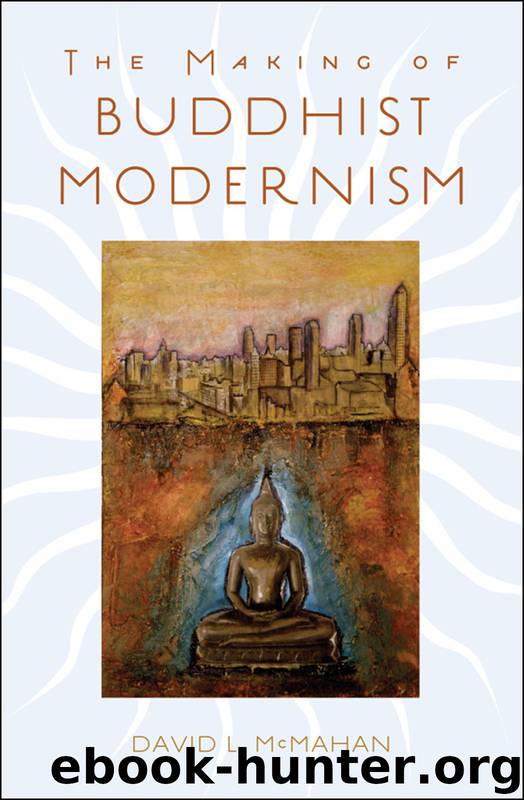The Making of Buddhist Modernism by McMahan David L.;

Author:McMahan, David L.;
Language: eng
Format: epub
Publisher: Oxford University Press USA - OSO
Published: 2005-03-14T16:00:00+00:00
Classical and Medieval Buddhist Views of Nature
Dependent Origination in Classical Pali Literature
The Buddha, as is often repeated, said he taught only two things: suffering and the end of suffering. No doubt, Buddhists and Buddhist institutions have supported efforts to relieve suffering throughout history. The moral ideal of compassion for all living beings cannot help but harmonize with the various modern efforts to feed the hungry, heal the sick, and promote economic and environmental sustainability for people and animals. The great number of Buddhists around the world active in these efforts are undoubtedly acting in accordance with the basic Buddhist principles of universal compassion and relief of suffering. But the Pali suttas do not present temporary relief of suffering as the dharma’s ultimate goal. Buddhism has always employed means of such relief, both natural and supernatural, but the “end of suffering” the Buddha declared was to be permanent. The postmortem state of parinirvān.a, or nirvana without the substratum of the five skandhas, the aggregates of personal existence, was beyond suffering because it was beyond time and space, beyond becoming, beyond personal existence, beyond all conditioned things. It was by definition nearly unimaginable—everything the phenomenal world of transience and rebirth was not. No doubt the vast majority of Buddhists throughout history have been lay people who did not aspire to such a remote goal. Even most monks, it turns out, have not considered this a realistic aspiration in this lifetime, given the age of decline in which we live. The ideal, however, is at the heart of the symbolic world of Buddhism.
The Pali suttas arose out of an ascetic milieu that viewed family, reproduction, physical pleasures, material success, and worldly life as ultimately futile, disappointing, and binding. Dependent origination denotes in early Buddhist literature the chain of causes and conditions that give rise to all phenomenal existence in the world of impermanence, birth, death, and rebirth (samsara). Far from being celebrated as a wondrous web of interconnected life, it is repeatedly referred to as a “mass of suffering” (duhkha). Indeed, it is through the reversal of this chain of interdependent causation—not an identification with it—that the Buddha is said to have become awakened. The “world” (loka) itself is conceived as a flow of phenomenal events that are dependent on contact between the senses and sense objects, consciousness and objects of consciousness. It does not exist in and of itself but arises with the intertwining of a falsely reified subject and object. The point of the many Pali passages elucidating the relationships between the various kinds of consciousness and its objects—visual consciousness and objects of vision, auditory consciousness and sounds, and so on—is to help the monk learn how to disidentify with the phenomenal world as it is constituted by this intertwining of consciousness and its objects based on craving, aversion, and delusion (SN 12.44). While modern Buddhists and scholars sometimes present the chain of dependent origination as a kind of empirical theory of causality, it was meant to illuminate not the arising
Download
This site does not store any files on its server. We only index and link to content provided by other sites. Please contact the content providers to delete copyright contents if any and email us, we'll remove relevant links or contents immediately.
The Lost Art of Listening by Michael P. Nichols(6492)
Why I Am Not A Calvinist by Dr. Peter S. Ruckman(3778)
The Rosicrucians by Christopher McIntosh(3062)
Wicca: a guide for the solitary practitioner by Scott Cunningham(2712)
Signature in the Cell: DNA and the Evidence for Intelligent Design by Stephen C. Meyer(2508)
Real Sex by Lauren F. Winner(2490)
The Holy Spirit by Billy Graham(2435)
To Light a Sacred Flame by Silver RavenWolf(2361)
The End of Faith by Sam Harris(2301)
The Gnostic Gospels by Pagels Elaine(2041)
Nine Parts of Desire by Geraldine Brooks(2011)
Waking Up by Sam Harris(1969)
Heavens on Earth by Michael Shermer(1961)
Devil, The by Almond Philip C(1910)
Jesus by Paul Johnson(1895)
The God delusion by Richard Dawkins(1858)
Kundalini by Gopi Krishna(1830)
Chosen by God by R. C. Sproul(1770)
The Nature of Consciousness by Rupert Spira(1694)
